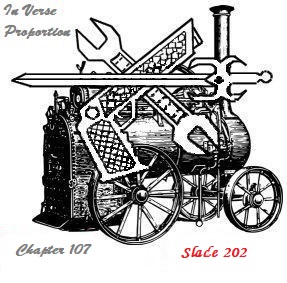
Patreon or PayPal Me keeps this site and its author alive. Thank you. |
Stories from the Verse
In Verse Proportion
Chapter 107: Slade 202
Table of Contents
Previous chapter: Kondor 210

Slade let the student explain bullets to the professor, who listened intently. Finally he responded.
“I see. Reload time would be reduced significantly, and ramrods would no longer be needed. It would be a much more efficient weapon.”
“Yeah, but there’s more to it than that,” Slade said.
“More?” the professor and the student said in unison.
“See if you can follow me on this. We build a pistol. The barrel and the firing mechanism are separated by a gap. In that gap we insert a cylinder on an axle, in which are five or six drilled-through holes. Put one bullet in each hole, and fit the axle to the gun with a mechanism that turns it. When the operator pulls the trigger, the hammer draws back, the cylinder turns aligning the next hole perfectly between the barrel and the hammer, and then the hammer falls, the gunpowder explodes, and the bullet flies out the barrel. But then he pulls the trigger again, and the gun reloads itself, five or six bullets before you have to remove the cups and reload the weapon.”
The professor seemed astonished.
“Or, here’s something else. Mount a bunch of rifle barrels on a ring with a gear system. Make the barrels go around in a circle, but angle them out just a bit, so that the one on top is pointed straight ahead but all the others are sloped slightly down. Turning the crank operates the system. When a barrel reaches the top, it engages the firing mechanism and shoots the waiting bullet. When it reaches the bottom--and notice that it’s had a bit of time to cool--a second mechanism replaces the spent cup with a fresh bullet. As long as you can keep loading bullets into the bottom mechanism and keep turning the crank, you can keep firing, maybe as fast as a bullet every second. Put the whole thing on a swivel, and you can sweep across a line of advancing attackers with devastating impact.”
“A mechanized gun!” the professor said.
“I’ve got two more ideas for you; the next one’s easy. Create a wide-barreled gun, maybe an inside diameter as thick as my thumb,” and he held up his thumb, "maybe thicker, not twice that, though, I think. Make shallow cups that fit, and then glue a paper cylinder into them, maybe as long as my fingers. You can fill that cylinder with all kinds of things--small metal pellets which would spread out and wound several targets at once, chunks of salt which will sting but probably not kill, rubber balls which similarly would hurt but wouldn’t be fatal, balls of wax with phosphorus and sulfur that would ignite in flight, even large spheres that would do serious damage to targets at shorter ranges.”
He waited a moment for this to sink in, then continued. “Finally, and this would be the hardest, when you fire a bullet you get kick--one of those laws of physics, the force that pushes the slug out the barrel also pushes the cup the opposite direction. You counter that by making sure it’s secure, but it also pushes back against the user. But think: you could use that force. You just have to build a mechanism that will let the cup push back against a spring-loaded lever, which then ejects the cup and slips another bullet from a feed system into the space and readies it for firing. You get the effect of the cylinder gun, but you could get the speed of the multi-barreled gun. You could even set it up so that as long as the trigger is pulled the gun repeatedly reloads and fires. Now that would be a genuine mechanized gun.”
Everyone sat in silence for what to Slade seemed several minutes. Finally he said, “So?”
The professor made the sort of whistling noise Slade had come to recognize as the equivalent of clearing his throat.
Then he said, “Bob,” in that English mimicking that they used when they spoke his name, “I think you have just revolutionized warfare in our world.”
He smiled. “Well, I am a god of war, as it were,” he said. “If we get past this, and get that motor working, maybe we can work on building a tank.”
He got a blank stare from that, but he wasn’t worried about it. They were going to be working on this for a while. Dangling the notion that he has another idea in the wings was what he called job security.
There is a behind-the-writings look at the thoughts, influences, and ideas of this chapter, along with twenty other sequential chapters of this novel, in mark Joseph "young" web log entry #452: Versers Ready. Given a moment, this link should take you directly to the section relevant to this chapter. It may contain spoilers of upcoming chapters.
As to the old stories that have long been here:

